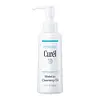What's inside
What's inside
 Key Ingredients
Key Ingredients

 Benefits
Benefits

 Concerns
Concerns

 Ingredients Side-by-side
Ingredients Side-by-side

Glycerin
HumectantWater
Skin ConditioningMethyl Gluceth-20
HumectantDicaprylyl Ether
EmollientButylene Glycol
HumectantIsononyl Isononanoate
EmollientBetaine
HumectantDimethicone
EmollientPEG-12 Laurate
EmulsifyingPolyglyceryl-2 Isostearate
EmulsifyingAcrylates/C10-30 Alkyl Acrylate Crosspolymer
Emulsion StabilisingCetyl Dimethylbutyl Ether
Skin ConditioningDecyl Glucoside
CleansingSodium Citrate
BufferingPotassium Hydroxide
BufferingIsostearyl Glyceryl Ether
Skin ConditioningCitric Acid
BufferingParfum
MaskingPEG-6
HumectantTocopherol
AntioxidantBHT
AntioxidantPhenoxyethanol
PreservativeCI 77891
Cosmetic ColorantGlycerin, Water, Methyl Gluceth-20, Dicaprylyl Ether, Butylene Glycol, Isononyl Isononanoate, Betaine, Dimethicone, PEG-12 Laurate, Polyglyceryl-2 Isostearate, Acrylates/C10-30 Alkyl Acrylate Crosspolymer, Cetyl Dimethylbutyl Ether, Decyl Glucoside, Sodium Citrate, Potassium Hydroxide, Isostearyl Glyceryl Ether, Citric Acid, Parfum, PEG-6, Tocopherol, BHT, Phenoxyethanol, CI 77891
Paraffinum Liquidum
EmollientIsononyl Isononanoate
EmollientPEG-12 Laurate
EmulsifyingOctyldodecanol
EmollientPolysorbate 80
EmulsifyingSorbeth-230 Tetraoleate
EmulsifyingDimethicone
EmollientIsododecane
EmollientCetyl Dimethylbutyl Ether
Skin ConditioningPolyglyceryl-2 Isostearate
EmulsifyingPolysorbate 85
EmulsifyingIsostearyl Glyceryl Ether
Skin ConditioningWater
Skin ConditioningSorbeth-60 Tetraoleate
EmulsifyingDipropylene Glycol
HumectantMyristyl Alcohol
EmollientButylene Glycol
HumectantPEG-5 Hydrogenated Castor Oil
EmulsifyingCholesteryl Isostearate
EmollientIsostearyl Glyceryl Pentaerythrityl Ether
EmollientPEG-6 Sorbitan Oleate
EmulsifyingSorbeth-40 Tetraoleate
EmulsifyingPEG-10 Hydrogenated Castor Oil
EmollientDipotassium Glycyrrhizate
HumectantSuccinic Acid
BufferingBHT
AntioxidantTocopherol
AntioxidantPhenoxyethanol
PreservativeParaffinum Liquidum, Isononyl Isononanoate, PEG-12 Laurate, Octyldodecanol, Polysorbate 80, Sorbeth-230 Tetraoleate, Dimethicone, Isododecane, Cetyl Dimethylbutyl Ether, Polyglyceryl-2 Isostearate, Polysorbate 85, Isostearyl Glyceryl Ether, Water, Sorbeth-60 Tetraoleate, Dipropylene Glycol, Myristyl Alcohol, Butylene Glycol, PEG-5 Hydrogenated Castor Oil, Cholesteryl Isostearate, Isostearyl Glyceryl Pentaerythrityl Ether, PEG-6 Sorbitan Oleate, Sorbeth-40 Tetraoleate, PEG-10 Hydrogenated Castor Oil, Dipotassium Glycyrrhizate, Succinic Acid, BHT, Tocopherol, Phenoxyethanol
 Reviews
Reviews

Ingredients Explained
These ingredients are found in both products.
Ingredients higher up in an ingredient list are typically present in a larger amount.
BHT is a synthetic antioxidant and preservative.
As an antioxidant, it helps your body fight off free-radicals. Free-radicals are molecules that may damage your skin cells.
As a preservative, it is used to stabilize products and prevent them from degrading. Specifically, BHT prevents degradation from oxidation.
The concerns related to BHT come from oral studies; this ingredient is currently allowed for use by both the FDA and EU.
However, it was recently restricted for use in the UK as of April 2024.
Learn more about BHTButylene Glycol (or BG) is used within cosmetic products for a few different reasons:
Overall, Butylene Glycol is a safe and well-rounded ingredient that works well with other ingredients.
Though this ingredient works well with most skin types, some people with sensitive skin may experience a reaction such as allergic rashes, closed comedones, or itchiness.
Learn more about Butylene GlycolWe don't have a description for Cetyl Dimethylbutyl Ether yet.
Dimethicone is a type of synthetic silicone created from natural materials such as quartz.
What it does:
Dimethicone comes in different viscosities:
Depending on the viscosity, dimethicone has different properties.
Ingredients lists don't always show which type is used, so we recommend reaching out to the brand if you have questions about the viscosity.
This ingredient is unlikely to cause irritation because it does not get absorbed into skin. However, people with silicone allergies should be careful about using this ingredient.
Note: Dimethicone may contribute to pilling. This is because it is not oil or water soluble, so pilling may occur when layered with products. When mixed with heavy oils in a formula, the outcome is also quite greasy.
Learn more about DimethiconeIsononyl Isononanoate is a synthetic skin-conditioner and texture enhancer. It is created from nonanoic acid, a fatty acid found in cocoa and lavender oil.
As an emollient, Isononyl Isononanoate helps keep your skin soft and smooth. This is because emollients create a barrier on the skin to trap moisture in.
Isononyl Isononanoate helps give products a velvet feel and improves spreadability.
Learn more about Isononyl IsononanoateWe don't have a description for Isostearyl Glyceryl Ether yet.
PEG-12 Laurate isn't fungal acne safe.
Phenoxyethanol is a preservative that has germicide, antimicrobial, and aromatic properties. Studies show that phenoxyethanol can prevent microbial growth. By itself, it has a scent that is similar to that of a rose.
It's often used in formulations along with Caprylyl Glycol to preserve the shelf life of products.
Polyglyceryl-2 Isostearate isn't fungal acne safe.
Tocopherol (also known as Vitamin E) is a common antioxidant used to help protect the skin from free-radicals and strengthen the skin barrier. It's also fat soluble - this means our skin is great at absorbing it.
Vitamin E also helps keep your natural skin lipids healthy. Your lipid skin barrier naturally consists of lipids, ceramides, and fatty acids. Vitamin E offers extra protection for your skin’s lipid barrier, keeping your skin healthy and nourished.
Another benefit is a bit of UV protection. Vitamin E helps reduce the damage caused by UVB rays. (It should not replace your sunscreen). Combining it with Vitamin C can decrease sunburned cells and hyperpigmentation after UV exposure.
You might have noticed Vitamin E + C often paired together. This is because it is great at stabilizing Vitamin C. Using the two together helps increase the effectiveness of both ingredients.
There are often claims that Vitamin E can reduce/prevent scarring, but these claims haven't been confirmed by scientific research.
Learn more about TocopherolWater. It's the most common cosmetic ingredient of all. You'll usually see it at the top of ingredient lists, meaning that it makes up the largest part of the product.
So why is it so popular? Water most often acts as a solvent - this means that it helps dissolve other ingredients into the formulation.
You'll also recognize water as that liquid we all need to stay alive. If you see this, drink a glass of water. Stay hydrated!
Learn more about Water